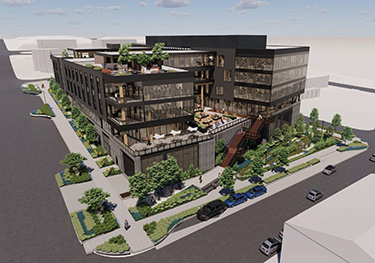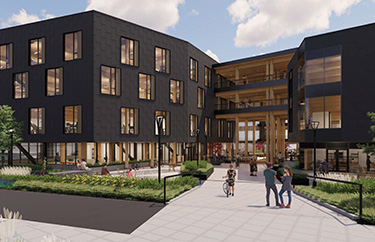|
Subscribe / Renew |
|
|
Contact Us |
|
| ► Subscribe to our Free Weekly Newsletter | |
| home | Welcome, sign in or click here to subscribe. | login |
Real Estate
| |
December 2, 2020
Dunn Lumber dials in design for Wallingford mass timber project
Real Estate Editor
Of course they would use wood. Dunn Lumber's planned new office/warehouse building, designed by Weber Thompson, will be a mostly mass timber project.
The family-owned company will develop its full block at 3800 Latona Ave. N.E. — not the current store location on the west block — with what it calls Latona Station. The east block project will have its next design review, probably virtual, in January.
Appropriate to the main building material, Weber Thompson is still employing its original “mortise and tenon”-inspired design, first seen a year ago. Thus the structure is divided into east and west wings, connected by open-air walkways above a large public plaza.
Latona Station will be a three- and four-story building with about 158,000 square feet of offices over a parking garage and 27,000-square-foot warehouse for Dunn. A showroom for the latter will face Latona, which slopes down to the south. The warehouse will have a drive-through loading bay. The building will essentially be two realms: mass timber on top, and concrete below.
Latona Station will evidently include some new offices for its owner — which calls that space an expansion, not a new headquarters. The bulk of the space will apparently be leased out.
The architect writes that Dunn “has decided not to pursue the Living Building Pilot Program. This is due to a new project goal of providing in-demand ‘laboratory-ready' office space to the market. This pivot to a lab-ready building made the LBPP infeasible for the project.”
As a result, the extra floor area that would've been allowed under the pilot program has been reduced, and building isn't quite as large. (The old design rose five stories above grade on its north side, facing Northeast Pacific Street.) The site slopes down to the south, where the new design will rise five stories above grade.
The mass timber office floors, above the lower concrete levels, now appear to have taller ceiling heights — as lab and life science tenants generally prefer. CBRE recently estimated that Seattle has the second tightest life science market in the nation, with a vacancy rate of only 2.2%.
About 9,500 square feet of retail is also planned. One large bay, indicated as a restaurant with outdoor seating, will overlook Northeast Northlake Way — and will have views of Lake Union. Two smaller bays will face north to the Burke-Gilman Trail and Pacific. There will also be a plaza with outdoor seating facing the trail.
About 167 parking stalls on three levels, one below grade, will be accessed from the east side of the block, a dead-end street. There will also be bicycle parking with around 200 stalls, plus showers for cycle commuters.
A south-facing roof deck is indicated for the three-story west wing; solar panels are possible for the roof of the four-story east wing. The south end of the plaza will feature a prominent scenic overlook, which then connects to stairs down to Northlake.
The main store, headquarters and lumberyard are on the west block. Dunn's east block, the future Latona Station, is now mostly used for parking, but also has some old tear-down buildings.
Roy Street Group helped plan the project. (Update: CoU LLC now says it’s the development partner with the Dunn family; CoU comprises Hess Callahan Partners and Mark Grey of Stephen C. Grey & Assoc. ) Other team members haven't been disclosed. Dunn is now in its fifth generation of family leadership. The company was founded in Wisconsin in 1907. It's been at its present location, the former Holmes Lumber & Fuel building, since 1931.
Latona Station will be Weber Thompson's second mass timber project in the Fremont-Wallingford area. The first was Cedar Speedster, about two miles west in Fremont. And the architect itself will relocate to the new, deep-green Watershed building, which used conventional construction, also in Fremont.
Brian Miller can be
reached by email at brian.miller@djc.com or by phone at (206) 219-6517.




